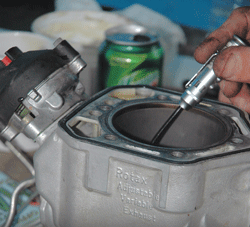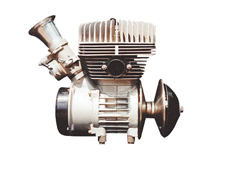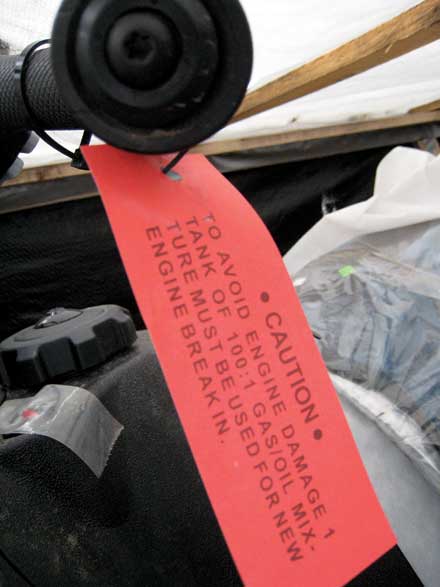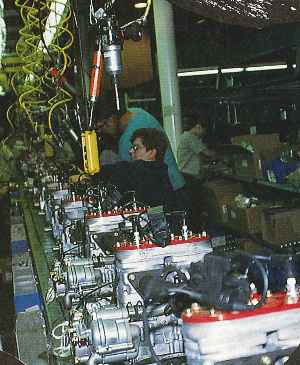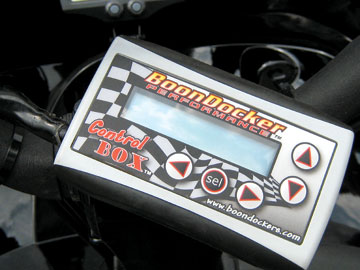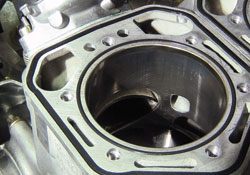Those compounds, measured by the U.S. Environmental Protection Agency (EPA), are unburned hydrocarbons (HC), carbon monoxide (CO2), nitrogen oxides (NOx) and particulate matter (PM). Many other compounds are also in exhaust, such as carbon dioxide (CO2), water (H2O) and a number of compounds made up of elements found in the gasoline blends, air and oil blends.
In 2001, the EPA estimated the percentage contributions made by snowmobiles to the overall output in the U.S. to be: HC 1.2 percent, CO 0.5 percent, NOx 0.007 percent and PM 0.07 percent.
This is truly a tiny contribution to the total emissions released in a year, but snowmobile engines were lumped in with many off-road engine types and standards were established for them all.
In the case of snowmobiles, the EPA measures and regulates only HC and CO levels in the exhaust. Levels of NOx are inherently low in two-stroke engines because of their lower combustion chamber temperatures. While four-stroke engines will have higher NOx emissions, they are not of great concern in the winter when temperatures aren’t high enough to act as the catalyst to create smog. Particulate matter is an issue with diesel engines and the EPA does not anticipate the application of diesel engines in snowmobiles.
CO2 is not a pollutant. If it were, we would all be dead because that’s what we release every time we exhale. The people who scream “Global warming! Global warming!” however, say that good old CO2, which is feeding all our plant life, is the key compound that is creating the “greenhouse” effect. The fact is only 5 percent of the entire planet’s CO2 is man-made and only .5 percent of it is produced by the automotive industry. That won’t stop people from demanding more and more regulations, though. For the immediate future, CO2 will not be a compound that the EPA is going to be concerned with.
This is the first season for implementation of the EPA’s snowmobile emission regulations, though manufacturers have been building compliant models and banking credits since 2003. For this season, 50 percent of a manufacturer’s production must be compliant with the new emission standards.
The emissions are measured in grams per kilowatt-hour (g/kW-hr); 1 hp = 0.746 kW. An engine is run on a dynamometer and operated using a five-mode cycle that mimics typical field use of the snowmobile. The fact that the sampling is measured against the kW-hr means there is an advantage for manufacturers to clean up the larger, more powerful engines first and bank credits that can be used to lower the fleet average or extend the use of non-compliant engines.
For model years 2006 through 2009, which is the first level of the EPA standards phase-in, the EPA standard is 100 g/kW-hr HC and 275 g/kW-hr CO. This first step results in a decrease of 30 percent of these pollutants, in complying engines, over the previous industry baseline. Again, for 2006 only, a manufacturer must have 50 percent of its fleet meet the standards. The manufacturer may select which models it will use in the mix. This is part of the EPA’s phase-in process.
For the years 2007 through 2009, 100 percent of a manufacturer’s fleet must meet the standards first set in 2006. Fleet averaging will still be used. Another concern of the EPA’s is permeation of fuel vapors from the fuel system, which add to HC emissions.
In 2008, permeation limits will be required of fuel systems. Permeation refers to the evaporative loss of fuel from the fuel tank and fuel lines of a snowmobile. Fuel tanks will be allowed a rate of evaporation of 1.5 g/m2 per day with a deterioration factor included. Fuel lines will be allowed a permeation rate of 15 g/m2 per day with no deterioration factor included. Current polyethylene fuel tanks will not meet these standards and will likely lead to the use of metal fuel tanks or new plastic compounds using some sort of fuel cell or bladder contained within the tank.
Phase two of the EPA standards phase-in includes model years 2010 and 2011. Hydrocarbon emission will be lowered to 75 g/kW-hr, and CO emissions will remain at 275 g/kW-hr. All of the fleet must meet the requirement and fleet averaging will again be allowed. This means that credits banked from previous years can still be used to compute the average.
Phase three of the standards implementation begins with model year 2012. At this time, the emission limits have not been set nor has the implementation of fleet averaging or the use of individual model caps.
The actual certification procedure is accomplished using this formula: FEL = OTR + DF +PT.
Family Emissions Level (FEL): This is the final number used to determine a fleet’s compliance.
Official Test Result (OTR): This is the official test result from the dynamometer testing and is conducted by each manufacturer.
Deterioration Factor (DF): A minimum of two engines are retested after 400 hours or 10,000 km to see how they hold up over time to emission standards.
Production Tolerance (PT): Because these engines are mass-produced, provision is made for production tolerances.
Once the calculation is completed, the FEL of each qualifying engine will be noted on the engine’s exhaust emission label. To inform the consumer of the engine’s emission rating, a hang tag is provided with each machine that has qualified. The tag will identify the engine type and list its Normalized Emission Rating (NER). The NER is a scale from 0 to 10, with 0 being the cleanest. The tag must not be removed from the machine until after its retail sale. The NER that a manufacturer’s engine must meet for phase one of the EPA program is “8.”
To save the small snowmobile manufacturers the enormous burden and expense of certifying their engines, the EPA created an exception. Manufacturers producing less than 600 machines in a single model year are relieved of the need to certify with the EPA.
The EPA has a Web site that shows which engines from each manufacturer are approved: www.epa.gov/otaq/certdata.htm. Scroll down the first page until you see “snowmobile.”
The EPA imposes no requirements on engine design to meet their standards. It’s left entirely to the manufacturer. We’ve seen a number of approaches used to meet the emission requirements, but let’s take a little closer look at them.
All four major manufacturers are, or have been, involved in other motor sports including motorcycles, outboards, personal watercraft and ATVs. There’s a lot of crossover technology that’s now in use and there will be more.
Arctic Cat, Polaris and Ski-Doo utilize both four-stroke and two-stroke engines to meet the 2006 emission level rulings. As of this past fall, however, only BRP has an approved two-stroke design noted. All other engines that are currently approved are four-stroke designs. Yamaha seems to have committed to the application of four-stroke designs for its snowmobiles even though it has direct injection technology in use in its marine group.
One of the major advancements that has allowed the engines to be cleaned up, both two-stroke and four-stroke designs, is the application of more sensors, and the use of increasingly powerful engine management computers. Much of this technology and the programs used have been initially developed by the automotive industry.
The key to cleaning up either a two-stroke or four-stroke engine is a matter of making combustion as complete as possible. This eliminates as much HC and CO as possible without an extraordinary effort. Combustion chamber shapes, cam timing and port timing, fuel injector placement and aim, exhaust system design, fuel injection timing and ignition timing, all have an effect on combustion. These aspects of engine design are continually refined on all engines.
In the case of two-stroke engines, the key to cleaning them up is to reduce the HC emissions. Electronic control of fuel delivery, ignition timing, exhaust valve opening and control of detonation have allowed even carbureted engines to meet the 2006 emission standards. The only such engine certified at this time is BRP’s 800 H.O. PowerTEK engine. The engine management system and the ability to adjust many features of the engine allow it to meet the standards.
BRP’s 600 and 1000 SDI engines and Polaris’ CleanFire 700 and 900 are both EFI designs but the injectors are not placed in the throttle bodies. In BRP’s design, two injectors mount in the transfer ports of each cylinder. In Polaris’ version, one injector mounts in the crankcase of each cylinder and one mounts in each cylinder. These designs allow the cylinder to be scavenged with pure air before the fuel is injected. The injector placed closer to the cylinder means the fuel can be injected later in the stroke, just before the exhaust port closes.
The ultimate in cleanliness in two-strokes, which may be required by the EPA in the future, is accomplished with direct injection (DI). In the case of DI, fuel is injected directly into the combustion chamber, by one of a number of methods, after the exhaust port is closed. A number of different DI systems are in use in the personal watercraft and outboard motor industry. The cleanest outboard motor available today, including four-stroke and two-stroke designs is BRP’s Evinrude E-TEC line of two-stroke, DI engines.
In the case of cleaning up four-strokes, it is a matter of tightly controlling fuel delivery and ignition timing as well as combustion chamber design to achieve as complete combustion as possible. The high combustion chamber temperatures and pressures produce higher levels of CO. As we look to the future and tighter emission levels, air injection into the exhaust may be required to help complete combustion of the CO. Catalytic converters could also be used, as in automobiles, to convert CO into CO2.
The EPA and the manufacturers have a good working relationship that has already spawned some interesting designs. As we look to the future, model year 2012 will be very interesting.

